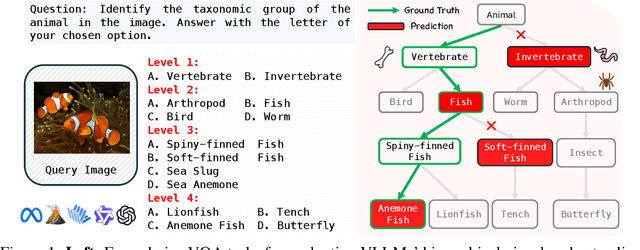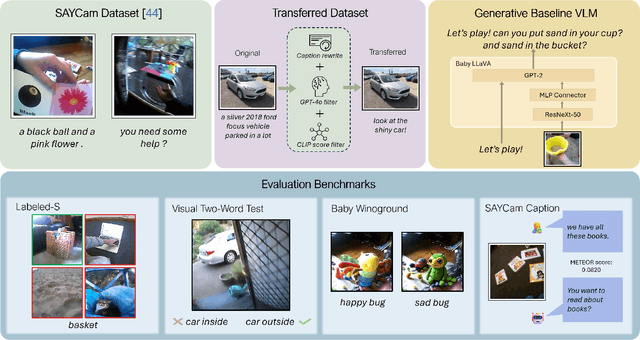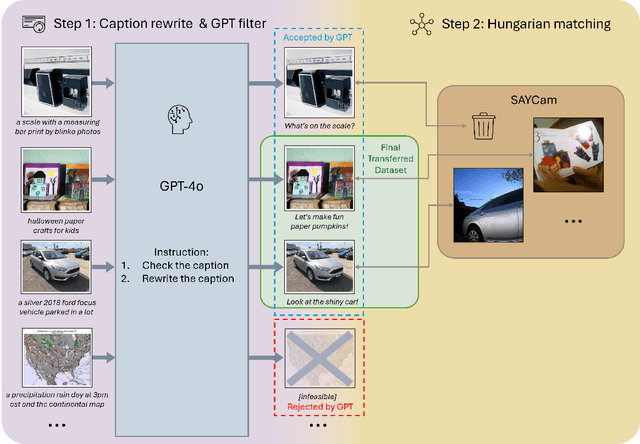Boqing Gong
Lifting Data-Tracing Machine Unlearning to Knowledge-Tracing for Foundation Models
Jun 12, 2025Abstract:Machine unlearning removes certain training data points and their influence on AI models (e.g., when a data owner revokes their decision to allow models to learn from the data). In this position paper, we propose to lift data-tracing machine unlearning to knowledge-tracing for foundation models (FMs). We support this position based on practical needs and insights from cognitive studies. Practically, tracing data cannot meet the diverse unlearning requests for FMs, which may be from regulators, enterprise users, product teams, etc., having no access to FMs' massive training data. Instead, it is convenient for these parties to issue an unlearning request about the knowledge or capability FMs (should not) possess. Cognitively, knowledge-tracing unlearning aligns with how the human brain forgets more closely than tracing individual training data points. Finally, we provide a concrete case study about a vision-language FM to illustrate how an unlearner might instantiate the knowledge-tracing machine unlearning paradigm.
Vision LLMs Are Bad at Hierarchical Visual Understanding, and LLMs Are the Bottleneck
May 30, 2025



Abstract:This paper reveals that many state-of-the-art large language models (LLMs) lack hierarchical knowledge about our visual world, unaware of even well-established biology taxonomies. This shortcoming makes LLMs a bottleneck for vision LLMs' hierarchical visual understanding (e.g., recognizing Anemone Fish but not Vertebrate). We arrive at these findings using about one million four-choice visual question answering (VQA) tasks constructed from six taxonomies and four image datasets. Interestingly, finetuning a vision LLM using our VQA tasks reaffirms LLMs' bottleneck effect to some extent because the VQA tasks improve the LLM's hierarchical consistency more than the vision LLM's. We conjecture that one cannot make vision LLMs understand visual concepts fully hierarchical until LLMs possess corresponding taxonomy knowledge.
SITE: towards Spatial Intelligence Thorough Evaluation
May 08, 2025Abstract:Spatial intelligence (SI) represents a cognitive ability encompassing the visualization, manipulation, and reasoning about spatial relationships, underpinning disciplines from neuroscience to robotics. We introduce SITE, a benchmark dataset towards SI Thorough Evaluation in a standardized format of multi-choice visual question-answering, designed to assess large vision-language models' spatial intelligence across diverse visual modalities (single-image, multi-image, and video) and SI factors (figural to environmental scales, spatial visualization and orientation, intrinsic and extrinsic, static and dynamic). Our approach to curating the benchmark combines a bottom-up survey about 31 existing datasets and a top-down strategy drawing upon three classification systems in cognitive science, which prompt us to design two novel types of tasks about view-taking and dynamic scenes. Extensive experiments reveal that leading models fall behind human experts especially in spatial orientation, a fundamental SI factor. Moreover, we demonstrate a positive correlation between a model's spatial reasoning proficiency and its performance on an embodied AI task.
BabyVLM: Data-Efficient Pretraining of VLMs Inspired by Infant Learning
Apr 13, 2025



Abstract:Human infants rapidly develop visual reasoning skills from minimal input, suggesting that developmentally inspired pretraining could significantly enhance the efficiency of vision-language models (VLMs). Although recent efforts have leveraged infant-inspired datasets like SAYCam, existing evaluation benchmarks remain misaligned--they are either too simplistic, narrowly scoped, or tailored for large-scale pretrained models. Additionally, training exclusively on infant data overlooks the broader, diverse input from which infants naturally learn. To address these limitations, we propose BabyVLM, a novel framework comprising comprehensive in-domain evaluation benchmarks and a synthetic training dataset created via child-directed transformations of existing datasets. We demonstrate that VLMs trained with our synthetic dataset achieve superior performance on BabyVLM tasks compared to models trained solely on SAYCam or general-purpose data of the SAYCam size. BabyVLM thus provides a robust, developmentally aligned evaluation tool and illustrates how compact models trained on carefully curated data can generalize effectively, opening pathways toward data-efficient vision-language learning paradigms.
VideoAds for Fast-Paced Video Understanding: Where Opensource Foundation Models Beat GPT-4o & Gemini-1.5 Pro
Apr 12, 2025Abstract:Advertisement videos serve as a rich and valuable source of purpose-driven information, encompassing high-quality visual, textual, and contextual cues designed to engage viewers. They are often more complex than general videos of similar duration due to their structured narratives and rapid scene transitions, posing significant challenges to multi-modal large language models (MLLMs). In this work, we introduce VideoAds, the first dataset tailored for benchmarking the performance of MLLMs on advertisement videos. VideoAds comprises well-curated advertisement videos with complex temporal structures, accompanied by \textbf{manually} annotated diverse questions across three core tasks: visual finding, video summary, and visual reasoning. We propose a quantitative measure to compare VideoAds against existing benchmarks in terms of video complexity. Through extensive experiments, we find that Qwen2.5-VL-72B, an opensource MLLM, achieves 73.35\% accuracy on VideoAds, outperforming GPT-4o (66.82\%) and Gemini-1.5 Pro (69.66\%); the two proprietary models especially fall behind the opensource model in video summarization and reasoning, but perform the best in visual finding. Notably, human experts easily achieve a remarkable accuracy of 94.27\%. These results underscore the necessity of advancing MLLMs' temporal modeling capabilities and highlight VideoAds as a potentially pivotal benchmark for future research in understanding video that requires high FPS sampling. The dataset and evaluation code will be publicly available at https://videoadsbenchmark.netlify.app.
DAVE: Diverse Atomic Visual Elements Dataset with High Representation of Vulnerable Road Users in Complex and Unpredictable Environments
Dec 28, 2024



Abstract:Most existing traffic video datasets including Waymo are structured, focusing predominantly on Western traffic, which hinders global applicability. Specifically, most Asian scenarios are far more complex, involving numerous objects with distinct motions and behaviors. Addressing this gap, we present a new dataset, DAVE, designed for evaluating perception methods with high representation of Vulnerable Road Users (VRUs: e.g. pedestrians, animals, motorbikes, and bicycles) in complex and unpredictable environments. DAVE is a manually annotated dataset encompassing 16 diverse actor categories (spanning animals, humans, vehicles, etc.) and 16 action types (complex and rare cases like cut-ins, zigzag movement, U-turn, etc.), which require high reasoning ability. DAVE densely annotates over 13 million bounding boxes (bboxes) actors with identification, and more than 1.6 million boxes are annotated with both actor identification and action/behavior details. The videos within DAVE are collected based on a broad spectrum of factors, such as weather conditions, the time of day, road scenarios, and traffic density. DAVE can benchmark video tasks like Tracking, Detection, Spatiotemporal Action Localization, Language-Visual Moment retrieval, and Multi-label Video Action Recognition. Given the critical importance of accurately identifying VRUs to prevent accidents and ensure road safety, in DAVE, vulnerable road users constitute 41.13% of instances, compared to 23.71% in Waymo. DAVE provides an invaluable resource for the development of more sensitive and accurate visual perception algorithms in the complex real world. Our experiments show that existing methods suffer degradation in performance when evaluated on DAVE, highlighting its benefit for future video recognition research.
Neptune: The Long Orbit to Benchmarking Long Video Understanding
Dec 12, 2024



Abstract:This paper describes a semi-automatic pipeline to generate challenging question-answer-decoy sets for understanding long videos. Many existing video datasets and models are focused on short clips (10s-30s). While some long video datasets do exist, they can often be solved by powerful image models applied per frame (and often to very few frames) in a video, and are usually manually annotated at high cost. In order to mitigate both these problems, we propose a scalable dataset creation pipeline which leverages large models (VLMs and LLMs), to automatically generate dense, time-aligned video captions, as well as tough question answer decoy sets for video segments (up to 15 minutes in length). Our dataset Neptune covers a broad range of long video reasoning abilities and consists of a subset that emphasizes multimodal reasoning. Since existing metrics for open-ended question answering are either rule-based or may rely on proprietary models, we provide a new open source model-based metric GEM to score open-ended responses on Neptune. Benchmark evaluations reveal that most current open-source long video models perform poorly on Neptune, particularly on questions testing temporal ordering, counting and state changes. Through Neptune, we aim to spur the development of more advanced models capable of understanding long videos. The dataset is available at https://github.com/google-deepmind/neptune
Diffusion Autoencoders for Few-shot Image Generation in Hyperbolic Space
Nov 27, 2024



Abstract:Few-shot image generation aims to generate diverse and high-quality images for an unseen class given only a few examples in that class. However, existing methods often suffer from a trade-off between image quality and diversity while offering limited control over the attributes of newly generated images. In this work, we propose Hyperbolic Diffusion Autoencoders (HypDAE), a novel approach that operates in hyperbolic space to capture hierarchical relationships among images and texts from seen categories. By leveraging pre-trained foundation models, HypDAE generates diverse new images for unseen categories with exceptional quality by varying semantic codes or guided by textual instructions. Most importantly, the hyperbolic representation introduces an additional degree of control over semantic diversity through the adjustment of radii within the hyperbolic disk. Extensive experiments and visualizations demonstrate that HypDAE significantly outperforms prior methods by achieving a superior balance between quality and diversity with limited data and offers a highly controllable and interpretable generation process.
Extending Video Masked Autoencoders to 128 frames
Nov 20, 2024



Abstract:Video understanding has witnessed significant progress with recent video foundation models demonstrating strong performance owing to self-supervised pre-training objectives; Masked Autoencoders (MAE) being the design of choice. Nevertheless, the majority of prior works that leverage MAE pre-training have focused on relatively short video representations (16 / 32 frames in length) largely due to hardware memory and compute limitations that scale poorly with video length due to the dense memory-intensive self-attention decoding. One natural strategy to address these challenges is to subsample tokens to reconstruct during decoding (or decoder masking). In this work, we propose an effective strategy for prioritizing tokens which allows training on longer video sequences (128 frames) and gets better performance than, more typical, random and uniform masking strategies. The core of our approach is an adaptive decoder masking strategy that prioritizes the most important tokens and uses quantized tokens as reconstruction objectives. Our adaptive strategy leverages a powerful MAGVIT-based tokenizer that jointly learns the tokens and their priority. We validate our design choices through exhaustive ablations and observe improved performance of the resulting long-video (128 frames) encoders over short-video (32 frames) counterparts. With our long-video masked autoencoder (LVMAE) strategy, we surpass state-of-the-art on Diving48 by 3.9 points and EPIC-Kitchens-100 verb classification by 2.5 points while relying on a simple core architecture and video-only pre-training (unlike some of the prior works that require millions of labeled video-text pairs or specialized encoders).
OmnixR: Evaluating Omni-modality Language Models on Reasoning across Modalities
Oct 16, 2024Abstract:We introduce OmnixR, an evaluation suite designed to benchmark SoTA Omni-modality Language Models, such as GPT-4o and Gemini. Evaluating OLMs, which integrate multiple modalities such as text, vision, and audio, presents unique challenges. Particularly, the user message might often consist of multiple modalities, such that OLMs have to establish holistic understanding and reasoning across modalities to accomplish the task. Existing benchmarks are limited to single modality or dual-modality tasks, overlooking comprehensive multi-modal assessments of model reasoning. To address this, OmnixR offers two evaluation variants: (1)synthetic subset: a synthetic dataset generated automatically by translating text into multiple modalities--audio, images, video, and hybrids (Omnify). (2)realistic subset: a real-world dataset, manually curated and annotated by experts, for evaluating cross-modal reasoning in natural settings. OmnixR presents a unique evaluation towards assessing OLMs over a diverse mix of modalities, such as a question that involves video, audio, and text, providing a rigorous cross-modal reasoning testbed unlike any existing benchmarks. Our experiments find that all state-of-the-art OLMs struggle with OmnixR questions that require integrating information from multiple modalities to answer. Further analysis highlights differences in reasoning behavior, underscoring the challenges of omni-modal AI alignment.
 Add to Chrome
Add to Chrome Add to Firefox
Add to Firefox Add to Edge
Add to Edge